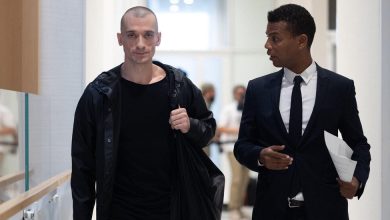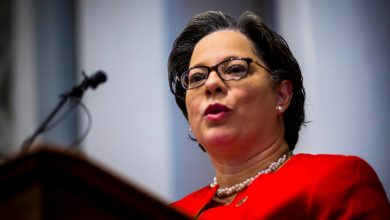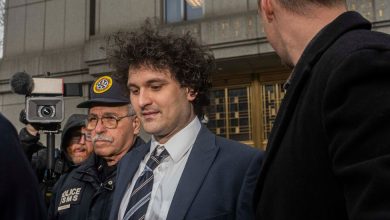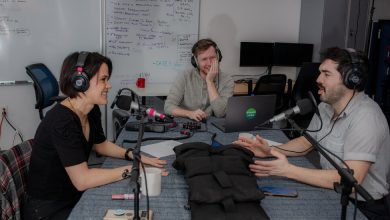The Aboriginal Australians Campaigning Against Constitutional Recognition

One calls for Aboriginal Australians to be treated like any other Australian. The other stands against what she sees as their forced assimilation.
They are hardly natural allies, but Jacinta Nampijinpa Price and Lidia Thorpe, two Indigenous Australian senators at opposite ends of the political spectrum, share one key view: In this weekend’s referendum, they argue, Australians should vote against amending the Constitution to recognize Aboriginal people and reject the “Voice,” a body that would advise Parliament on Indigenous issues.
They say that the Voice would be toothless and that the referendum has divided communities and families instead of uniting the country. They reject the notion that the Voice would empower and improve the lives of Australia’s Indigenous people, many of whom endure crushing poverty.
The vast majority of Aboriginal Australians say they support the Voice, making Ms. Price and Ms. Thorpe outliers. Their staunch opposition has catapulted them to the forefront of the debate and politics in Australia at a time when the issue has convulsed the country, ignited racially charged debates and led to accusations of disinformation on both sides.
In a sign of the two lawmakers’ surging influence, the referendum is widely expected to fail. Many voters see their stance as a sign of deeper divisions within the Aboriginal community, suggesting that a “no” vote is the safe option for a politically cautious country where most attempts to amend the Constitution have failed.
And while Ms. Price and Ms. Thorpe have reached their positions from drastically different perspectives, they both reflect a legacy of inadequate government policies toward Aboriginal Australians and the desire for bolder, very different approaches to race and inequality.
Ms. Price, a member of the center-right opposition National Party and former singer-songwriter, says the Voice would further separate and marginalize Aboriginal Australians — who represent around 3 percent of the population — and entrench the desperate hardship that many experience, especially in remote communities. Instead, she advocates changing traditional ways of life that she says are harmful or incompatible with a complex modern world.
“I see it as another extension of the welfare model, and of separatism separating Indigenous Australians along the lines of race,” Ms. Price, 42, said.
Ms. Thorpe, 50, is a leader of the “Blak Sovereign” Indigenous rights movement, which calls for a series of Indigenous-led treaties which would govern reparations. An outspoken independent senator who left the Green Party over dissent on the Voice, she says the measure would continue harmful policies of assimilation that have their roots in colonization.
“They want to make us all nice, neat little Indigenous Australians and end the Aboriginal problem, once and for all,” Ms. Thorpe said. “They think that by making us like them, assimilate us into their Constitution, that it’s going to fix the problem.”
Both women, first-time senators, are now contending with the trappings of higher profiles.
At a campaign event in Hobart, Tasmania, on Saturday, Ms. Price was interrupted by an audience member who called, to a loud cheer, “Jacinta for prime minister!” Ms. Price demurred: “Hey now, I’ve only been in the job for just over 12 months. Let’s get through this referendum.”
But as a prominent anti-Voice campaigner, Ms. Price, who is from Alice Springs in the Northern Territory, has faced abuse and has been accused of selling out and disrespecting her culture. “I’m a ‘coconut,’ an ‘Uncle Tom,’ all of those sorts of things,” she said.
Ms. Thorpe has become a kind of folk hero among her left-wing supporters, drawing crowds at Blak Sovereignty rallies and becoming the subject of murals in Melbourne, her home city. But she has faced political isolation, with many of her former allies now begrudgingly supporting the Voice, and she said she had received death threats, including from neo-Nazis, that had forced her out of her home and into exile for months at a time.
For Indigenous Australians backing the measure, hearing dissent from prominent Aboriginal campaigners felt sometimes bewildering, said Dane Simpson, an Aboriginal comedian who said he saw the Voice as a way for his community to have more say on the issues that affected it.
“Where are they coming from? What are they thinking about? Are they covering themselves, for a job?” he said of Aboriginal opponents to the proposal, adding, “I just can’t wrap my brain around it.”
But skeptics said that the efficacy of the Voice — whose precise details are yet to be decided — had been grossly overstated and that Aboriginal people had been led to believe that its potential powers were far greater and wider ranging than the reality.
“It can’t make a law, or even prevent a racist law being made in the federal Parliament,” said Michael Mansell, an Aboriginal lawyer from Launceston, Tasmania, who opposes the measure. “It cannot build a single house for a homeless Aboriginal family.”
The Voice is the first step of a three-pronged plan, developed by more than 250 Indigenous leaders who gathered at Uluru in 2017, which would eventually lead to a treaty and a process of “truth telling” about Australia’s colonial history. The incumbent Labor Party government has said the Voice would help guide policy on health, education, jobs and housing, areas in which Aboriginal Australians have long been disadvantaged.
But opponents have criticized that process and called for more drastic measures. Some, including Ms. Thorpe, say that the Voice forestalls a more powerful settlement between Aboriginal Australians and the modern Australian government.
“Why aren’t we given power?” Ms. Thorpe said. “Why is this advisory — why ‘advise’ us? What an insult to our intelligence, as the oldest continuing living culture on the planet.”
Ms. Price does not support a treaty or reparations. Instead, she has called for the Australian government to abandon its approach of culturally sensitive policy.
“There’s this sense that when it comes to Aboriginal kids, that they learn differently — they’re supposed to be connected to the land and all that sort of romantic thinking, ‘the noble savage,’” she said in an interview. “Aboriginal kids are kids, like any other kids. If they are provided the opportunity to have access to an education like anybody else, they can flourish.”
Ms. Thorpe wants Aboriginal people to have more of a say in such matters. “What the government keeps pushing down our throats is not good for us,” she said. “We have to control it ourselves. We have to self-determine what our destiny is.”
The threat of racial division suggested by Ms. Price has resonated with many voters. Volunteers campaigning against the Voice outside a large Saturday market in Hobart warned passers-by that a vote in favor would divide Australians and tear the country asunder.
Ms. Price echoed these themes later that evening at the campaign event.
Over 15 minutes, she expressed her love for Australia and “Australian values,” condemned “woke ideology” and denounced the identity politics that she said sought to intimidate “quiet Australians” into silence. At the same time, she suggested that if the idea of the Voice was to incorporate Aboriginal points of view, her identity as an Indigenous woman should be noted.
“We keep going, and we keep pushing, and we keep calling out this ridiculous government who claim that they want to listen to Aboriginal people. Well — hello?” she said, extending an arm above her head and waving. “Hello?”





